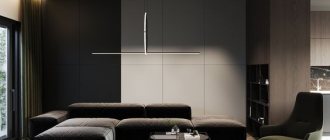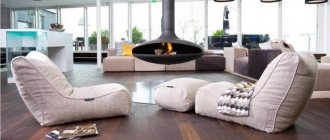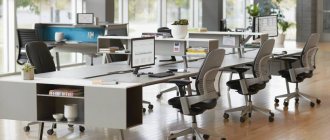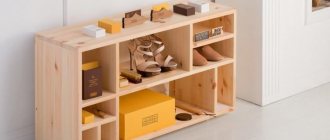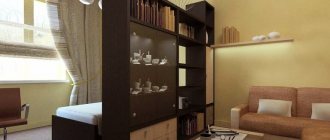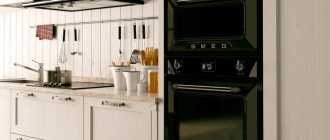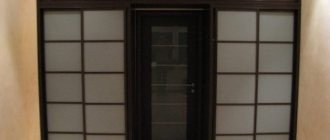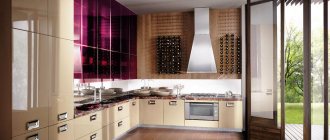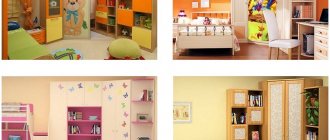<
>
In most countries, it is customary to take off your shoes in hallways. As a rule, in modern apartments they are not spacious in size, so the problem of organizing shoe storage is familiar to every family.
Boots and shoes placed on the floor are not only not aesthetically pleasing, but also not convenient: you can trip over them. In addition, constant contact of shoes with the floor contributes to the accumulation of dust and dirt on its surface. And products made from genuine leather often attract pets and can be hopelessly damaged if they have free access.
One of the best options for organizing shoe storage is to use shoe racks.
Shoe rack - purpose and advantages
A shoe rack is a special furniture structure designed for storing shoes and made in the form of a stand, cabinet, chest of drawers or cabinet.
The advantages of shoe racks include:
- organizing neat and compact shoe storage;
- keeping the hallway floors clean;
- preventing shoe deformation;
- convenience and ease of use.
The disadvantages of shoe racks depend on the type of design chosen. For example, dust can accumulate in open models, while closed shoe racks require additional space to open the door.
Varieties of shoe rack models
To choose a shoe rack that is right for you, you need to study and weigh the advantages and disadvantages of all types of such furniture.
Modern furniture manufacturers offer the following types of shoe racks:
- open shelving;
- shoe stands;
- cabinets;
- cabinets and chests of drawers;
- combined products.
Shoe racks
An open type rack is a stationary structure consisting of several sections. People call them galoshnitsy or galoshnitsy. The advantages of this type of shoe rack include low cost, continuous ventilation of shoes and the ability to use the upper tier as a stand for small items or a seat.
The main disadvantage of overshoes is that the shoes are visible - this does not always look aesthetically pleasing.
Shoe stands
A shoe stand is a structure consisting of several shelves (usually two to four). The distance between the shelves determines the type of shoes that can be stored on them. Low shelves are only suitable for summer and spring shoes, while high shelves allow you to store winter boots, felt boots and other types of warm footwear.
Many stands are equipped with a seat. This allows you to put on your shoes while sitting – a very convenient option for rationally organizing space in the hallway.
As a rule, shoe stands are made of metal or plastic and are open. The advantages of stands include compact size, practicality and durability. The main disadvantage is that shoes can get dusty and are always visible.
If you have pets in your home, it is better to give preference to closed shoe racks that will prevent pets from accessing your shoes.
Shoe cabinet
A shoe cabinet is a closed shelf equipped with doors. It provides aesthetic storage for shoes: they will always be hidden from prying eyes. However, it should be taken into account that wet shoes should not be stored in the closet.
There are three main types of shoe cabinets:
- a traditional wardrobe is a design with several spacious compartments, characterized by increased capacity. This is an excellent option for a spacious hallway;
- Bon's wardrobe - equipped with doors of different widths that open vertically. The shelves in this product are quite narrow, but high - an ideal solution for storing boots, bags and even umbrellas;
- Wardrobe Slim is a tall but narrow wardrobe. It is perfect when space is limited.
Shoe racks in the form of cabinets and chests of drawers
Dressers and cabinets are a shortened version of furniture for storing shoes. Therefore, they are good to place in rooms with low ceilings.
There are two types of shoe racks in the form of chests of drawers and cabinets:
- open - with or without side walls, but without doors;
- closed - with doors.
The design of the chest of drawers and the shoe cabinet are absolutely identical. The only difference between them is size. The chest of drawers is more spacious, and the cabinet is compact. It is best suited for tight hallways.
Combined shoe racks
Combined shoe racks include different types of shelves - closed or open. This allows you to keep everyday shoes close at hand, and rarely used ones in a locked cabinet. From a functionality point of view, this is the most convenient option for organizing shoe storage.
When choosing the type of shoe rack, be guided by the size of your hallway. Furniture should allow you to store shoes without compromising the usable space.
Preparing shoes
Before you start laying out your shoes and hiding them in all possible places, as long as they don’t get in the way, you need to prepare them for long-term storage, even if they are seasonal, or just shoes that you use now, but also in need of care and proper placement.
So, everything in order:
- Divide into seasonal: summer, winter, autumn-spring;
- In need of repair - repair;
- Remove laces and insoles;
- Clean shoes: wash fabric shoes, wipe leather shoes with a damp cloth, suede shoes with a dry brush or wrung-out sponge;
- Dry. All types of shoes should be dried only naturally; sun rays, heaters or radiators are not allowed;
- Treat the surface with special creams or sprays, give time for impregnation;
- It is advisable to fill boots and shoes with paper lumps or spacers to avoid deformation;
- Fold without bending the boot;
- Prepare a storage space.
Types of cases and materials
Depending on the installation capabilities, you can choose one of two types of shoe racks - built-in and cabinet-mounted.
A built-in shoe rack is located inside a wall niche or is an integral part of other furniture. Such solutions allow you to save space in the hallway. As a rule, such furniture is made to order, taking into account the exact dimensions of the space where the shoe rack will be placed.
The built-in shoe rack also makes it possible to hide the presence of flaws in the hallway: extra niches, uneven walls, unused hatches.
Cabinet models are free-standing shoe racks. They are highly mobile - if necessary, they can be moved from one place to another.
According to the method of placement, shoe racks are divided into floor-standing and hanging. The latter are attached to the wall and are more stable than floor structures.
Pay attention to the material from which the furniture is made. For the production of shoe racks they use:
- metal – used in shelving and shoe stands. It is distinguished by strength, durability and reliability. Typically, metal shoe racks are chrome-plated or powder-coated. It’s good if the furniture is coated with an anti-corrosion coating - this will significantly extend its service life. Metal shoe stands will fit perfectly into a classic interior;
- plastic is an aesthetic, but rather fragile material. It is used to create hallways in hi-tech style;
- Chipboard (chipboard) is the most common material for making shoe cases. It does not have high performance properties, but is inexpensive;
- natural wood is an expensive material, products made from it are strong and durable.
Please note that closed shoe racks should only be made of chipboard, wood or plywood - these are breathable materials. Products made of plastic and metal can only be of an open type.
How to store winter shoes
Shoes can be stored in hanging bags that do not take up much space on the walls.
In the summer, you have to hide bulky ankle boots, boots and over-the-knee boots to make room for bright flip-flops and high heels. Storing winter shoes does not require using the perimeter of the entire room; it is enough to apply the following tips:
take an ordinary clothesline, stretch it in a closet or dressing room and secure a pair with a clothespin (up to 7 pairs can fit on 1 m); knowing how to properly store winter shoes in a dressing room or closet, you can avoid damage and creases in the material, so it is important to maintain its shape by placing a pair on a shelf or rack at an angle; fold each pair into a textile bag, first filling the boots with crumpled paper, hang them in any room or fold them on mezzanines; Just don’t send your shoes to the balcony or garage (high humidity will easily ruin any material).
Types of shoe cabinet doors
There are three types of doors used in shoe cabinets:
- swing;
- sliding doors (sliding doors);
- folding.
Hinged doors are a classic option. Structurally, they are movable consoles that open towards themselves. This is the simplest version of the door opening mechanism. In addition, hinged doors provide maximum access to the contents of a closed shoe rack and are inexpensive.
But, to use such furniture, additional space is required so that the door can open unhindered. In a cramped hallway, such doors will only get in the way.
Sliding doors consist of two panels, firmly fixed on two guides - upper and lower. They allow you to save useful space in the hallway even with the shoe rack open. In addition, sliding doors look quite impressive and can fit into most modern interiors.
The disadvantages of sliding doors include high cost and poor visibility of the shelves: you will not be able to see all the contents of the cabinet at once.
Keep in mind that the use of sliding doors significantly reduces the usable depth of the cabinet - by at least 10 cm.
The folding door leaves are transformed according to the “accordion” or “book” principle and provide simple and quick access to the contents of the shoe rack. Unlike swing doors, they require very little space to open. In addition, folding doors are very light and easy to operate - even a child can handle them.
The only drawback of the folding design is that in the absence of lower guides, the door leaf can “walk”, that is, sway greatly during operation.
Internal filling of the shoe rack
The filling of a shoe rack is its internal structure. The functionality of the product largely depends on it.
The filling should provide comfortable storage of shoes and quick access to them if necessary. The choice of filling a shoe rack largely depends on the needs and tastes of its owner.
The main part of filling a closet or shoe rack is the shelves. They can be solid - on such a shelf you can place several pairs of shoes at once. Or they can be cells - separate compartments for each pair.
There are designs with drawers for shoes - a rather convenient solution for those who prefer orderliness in everything.
Shelves can be solid - made of chipboard, plastic or wood. But it is better to use lattice structures - they do not accumulate dust and dirt from the soles of shoes.
Folding shelves are very convenient to use - they slide into the cabinet body, while the shoes remain in place.
Shoe racks can be equipped with additional shelves for storing shoe cosmetics, as well as spacious compartments for accessories - umbrellas and bags.
How to prepare shoes for long-term storage
The construction of a shoe rack is always preceded by the preparation of shoes, which consists of several stages:
- Sorting. Review all available pairs. If shoes, boots or sneakers have lost their presentation, part with them. The same should be done with shoes that cannot be repaired. Pairs sorted by size are easier to store. Therefore, put boots, low shoes and Ugg boots to one side, and sneakers, creepers, sneakers to the other.
- The washing up. Clean the sole from dirt and the top from dust. Replace insoles if necessary. If you do not want fungus to colonize your shoes and boots, treat the inside with an antiseptic.
Properly prepared shoes can be stored in closed cabinets for years. At the same time, it does not acquire an unpleasant odor.
Photo of shoe racks in the interior
<
>
A properly selected shoe rack in the hallway not only saves space and ensures cleanliness, but can also become one of the stylish accents in the interior design of your home. The variety of shapes and designs of shoe racks allows you to choose furniture in full accordance with your tastes and preferences.
Color options
With the help of a black model, you can endow the environment with special elegance, style and originality; to create a calmer and more sophisticated interior composition in the spirit of minimalism, you can use furniture in white, gray or beige tones. Products with a glossy shiny surface, characterized by aesthetics and special smoothness, are a very effective solution.
The photo shows a narrow white shoe rack on the wall in the interior of a modern hallway.
A shoe shoe of dark brown or rich wenge color with an interesting texture will undoubtedly attract attention. This shade is universal, creates great combinations with other colors and harmoniously complements almost any hallway. In order to create an unusual and original design, colored shoe designs in bright colors are perfect. It is best to use such products in a more miniature design, since large models will add excessive diversity to the interior.
In the photo there is a corridor with a wooden shoe rack in a brown shade.

